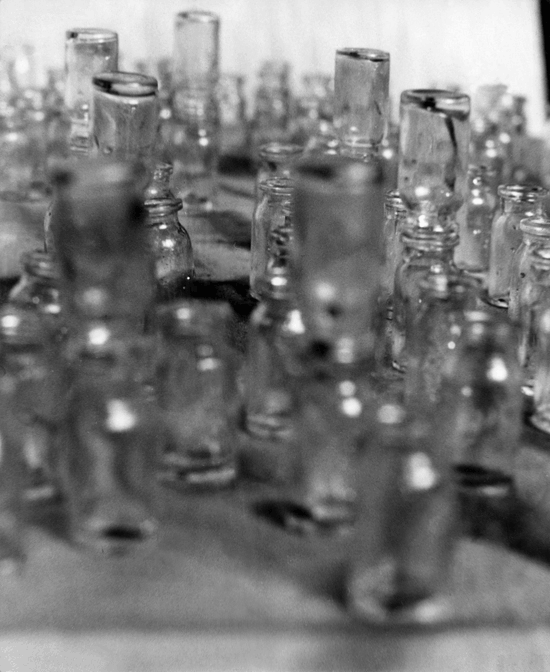Object & Installation

시각의 즐거움
1967, 가변설치(페니실린 병, 색지, 책상, 거울), ‘청년작가연립전’ (중앙공보관 화랑, 제2실, 서울, 1967) 출품, 국립현대미술관 소장
강국진은 ‘청년작가연립전’에서 페니실린 병과 거울을 이용하여 ‘시각’에 대해 탐구한 <시각의 즐거움>을 발표했다. 당시 한국 미술계에서는 시도된 적이 없는 매우 파격적인 테마이자 오브제였다. 그 작품은 <오늘의 시각> 및 <바로 오늘>이라는 두 작품과 함께 서로 상통하는 맥락을 지닌 듯 보인다. 테이블 위에 페니실린 병들이 쌓여있거나 눕혀져 있고 그 속에는 색지들이 들어있다. 그것들은 거울에 반사되기도 하고 서로를 반사하기도 하며 시각적인 착각을 일으킨다. 그에게 있어 인간의 시각은 보편적인 것도, 고정불변의 것도 아니었다. 시선의 각도와 위치에 따라 눈 앞에 펼쳐지는 광경은 끊임없이 변화하는 것이었고 그런 광경 자체가 ‘즐거움’을 야기시키는 것이었다. 원작은 소실되었으며, 2001년 강국진의 제자들(김영모 등)에 의해 재 제작되어 국립현대미술관에서 열린 ‘한국현대미술의 전개-전환과 역동의 시대’전에서 전시되었다. (김미경, 미술사학 박사 / 강남대 교수 / 한국예술연구소KARI 대표)
The Joy of Vision
1967, Variable installation (penicillin bottles, colored papers, table, mirror), ‘Chungnyun jakka yeunlipjun’ (Exhibition of young artist’s union), Exhibition hall 2, Gallery of ‘Joong Ang gongbokwan hwarang’ (Gallery of Joong Ang Public Information Center), Seoul, Korea, the National Museum of Contemporary Art Korea collection
At the ‘Chungnyun jakka yeunlipjun’ (Exhibition of young artist’s union), Kukjin Kang displayed Joy of Vision (1967) consisting of penicillin bottles and mirrors. The object piece was an unprecedented work and brought on a shock of its kind in Korean art world at the time. It contextually fitted in with Vision of Today and Just Today.
In it, there is a table on which the bottles are lying around or standing upright, and there are colored papers inside them. This scene is being reflected to produce kaleidoscopic views from different angles, somewhat confusing observers’ visual presuppositions. For Kang, this manifests as his view that human perspective on any subject is neither generalized nor unchangeable. A person’s view always differs from angle to angle, bringing in the sense of ‘joy’. The original work has been lost and was revisited by reproduction efforts of his students (Youngmo Kim and many more) for display at the National Museum of Contemporary Art Korea in the exhibition, ‘Korean Contemporary Art from mid‐1960s to mid‐1970s: A Decade of transition and dynamics’. (Mikyung Kim / Professor of Art History at Kangnam University / Director of Korean Art Research Institute)
KUKJIN KANG









